|
The ZX1 Monza Mirage
Package by Michigan Automotive Techniques Corporation |
|
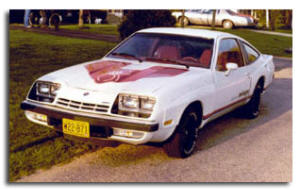
My Mirage had a one-of-a-kind
red spearhead on the hood with white spyder
and two red stripes painted on the rear
hatch. Mine didn't have a front air
dam either, but had a 305 V-8 and four speed
transmission. MATC's original blue/red decal
stripes had problems peeling off. This
prompted some owners to remove the decals
and paint instead. This may explain why my
car appeared differently.
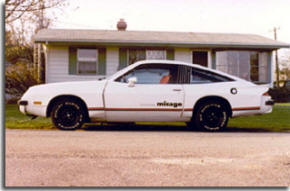
I kept the original hubcaps
off the car, they were surprisingly heavy
and had a tendency to pop off. But, I
gave them to the next owner when I sold the
car in '82. This car would look great with
black side pipes turning out below doors.
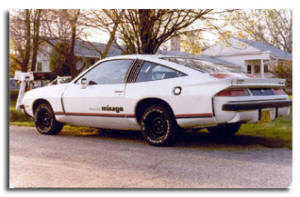
Weight distribution on V8
Monzas was about 58/42. The unibody
chassis had a lot flex, especially when you
got on the power or hit a turn hard and
fast. Unfortunately, the '77 Monza Mirage
didn't have a limited-slip differential
available, which the V-8 really needed to
keep the scrawny 13s from misbehaving. It
wasn't until the 1978 Monza Spyder model
rolled out, that a LSD was finally
available. |
The 1977 Chevrolet Monza Mirage is a special
edition 2+2 sports sedan based on GM's
H-body Monza. Michigan Auto Techniques
Corporation (MAT) of Grand Rapids, Michigan
produced the Mirage trim package for only
one year. They were an aftermarket company
contracted by GM to produce and install the
custom add-on package. It featured racing
stripes along the length of the car, flared
body panels, and a special air dam &
spoiler.
The vehicles were built in GM's St. Therese,
Quebec plant, and sent to MAT for
modification, after which they would ship
completed cars to the dealer. There were
approx 2,400 Monza Mirages made from MAT,
but there were also Mirages created by
Chevrolet dealerships, as the body add-ons
and stripes were available ordered through
dealer parts. The 5.0-liter (305 cid) engine
was the only V8 option for the 1977 model
year and highly recommended.
The Mirage's styling was modeled after the
specially prepared successful Monza racecars
that racked up an impressive record on the
track in 1975 and 1976 IMSA Camel GT
Challenge Series, long dominated by Porsche
and BMW. These racecars were also successful
in the SCCA Tran-Am pro series. Chevrolet
decided to draw on that fame to enhance
sales by making a "street version" of the
IMSA GT Monza that was burning up road
courses from Le Mans to Laguna Seca. It was
one of the smallest sport sedans available
with a V8 engine that came out of Detroit.
The idea of the design for the Mirage
appearance package originated with Grand
Rapids, Michigan-based BORT (British
Overseas Racing Team), an assemblage of
former Ford and Chrysler design staffers who
had made their mark by designing the Ford
Cobra II. Chevrolet contracted with BORT to
design an IMSA Monza “street version” and
MATC to install the kit's components, for
the 8,000 or more orders originally
anticipated.
The package was special ordered by the
Chevrolet dealer for customers. A complete
Monza was built on the assembly line at GM's
St. Therese plant in Quebec Canada, then
shipped to Grand Rapids where MATC applied
the custom Mirage trim panels, decals and
hub caps.
The add-on body panels were all made of
Reaction Injection Molded (RIM) urethane.
The complete body kit included a front air
dam, rear spoiler, front and rear fender
flares that were not nearly as wide as on
IMSA racecar. Then a special decal and
striping appearance package was applied to
doors, fenders, hood, roof, and the rear
hatch lid. "Monza Mirage" identification was
applied to both doors as well.
Everything was installed on the car except
the front air dam, which was to be installed
by the dealership upon arrival. It was a
precaution taken to avoid damaging the car’s
front air dam on the vehicle transport. The
Mirage's trim package by MATC was a visually
stunning package. The upgrade was less than
$700 for the consumer.
The only color available for the Monza 2+2
Sport Hatchback was Antique White (11L &
11U). Ordering the Firethorn red interior
was highly suggested to maintain the red
white and blue theme, but any color interior
was available. Another highly recommended
option was Chevrolet's new 305 cu. in. (LG3)
V8, although a few Mirages were actually
ordered with the base four cylinder engine.
The Mirage package options included Sport
Mirrors (D35), Sport Suspension (F41), Sport
Steering Wheel (N31), Special
Instrumentation (U14) and BR70-13/C Raised
White Lettered Radial Tires (QKZ).
MATC mounted a plaque on the dash pad of
every Mirage conversion it turned out, it
read, "Specially Prepared by Michigan
Automotive Techniques Corporation" followed
by a serial number. There were approximately
4,097 Mirages built, mostly by MATC. There
were a few Chevy dealerships that assembled
the Mirage package as well.
Production of the Monza Mirage was
originally scheduled to run through 1978
with other color options, but was
discontinued. Chevrolet had originally
planned to produce between eight and twelve
thousand Mirage models. Reasons for
cancellation of the special edition were
mainly a lower than expected sales, decal
stability issues, and there were royalties
due for the name 'Mirage'.
Chevrolet had disappointing sales with its
highly anticipated Monza line, having only
sold 73,348 units for 1977. Only 18% of all
Monza sales were the special edition Mirage
that was planned and designed to boost
sales. The Chevrolet Monza Spyder assumed
the role created by the Mirage for the 1978
production year. |
| |
|
| |
Owner's Impression |
|
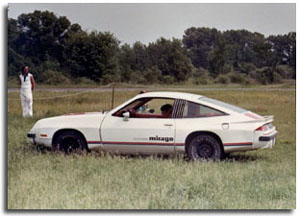
A corner F&C worker at
Blackhawk Farms, IL stands outside of
spectator safety line, which is a rope that
is barely noticeable. Now days, wooden snow
fence serves that purpose.
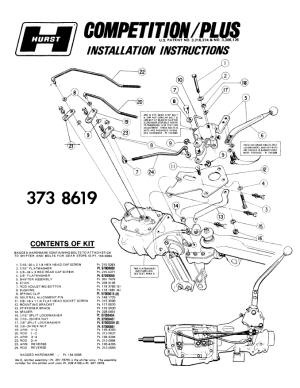
The Monza's 4-speed shifter
had short throws but easily bound up during
rapid shifts. My solution was a replacement
Hurst shifter that went for about $100 in
'81. It took a friend and I about 3 hours to
install. The hole on the tunnel had to be
enlarged slightly for the lever's clearance.
It hit against the sheet metal when thrown
into reverse. The end result was worth it.
Shifting the Saginaw transmission was still
sluggish when done too quickly, but the
precision and feel of gear selection was
improved and more accurate.
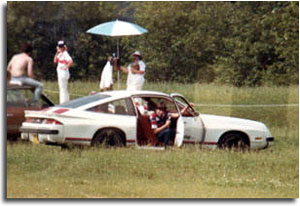
A day at the races. In 1981,
I drove it in a high speed autocross event
at Blackhawk Farms Raceway, a closed road
course. The event was sanctioned by
Midwestern Council of Sports Car Clubs.
|
My Monza
Mirage was less than two years old when I
became second owner in early '79. I bought
it from a used car dealer called Schoepp
Motors in Madison, WI, which was a small
shabby second-hand bargain lot. So, I was
surprised they were selling such a clean
sports coupe with some 8,000 miles on the
odometer. It was all too perfect, and
somehow too nice for that dealer to be
selling. The car had been on the lot for
over a month, it seemed to be waiting for
me. I took it as a sign and I wanted it.
The asking price was just $3,900, I barely
counter-offered with $3,600. In my mind the
car was already mine at the initial price.
After a quick confirmation the salesman
eagerly accepted, didn't think he'd go much
lower. I was already satisfied with the
original price. Immediately gave the
salesman a deposit and ran to the bank for a
loan. The banker looked up the car’s loan
value and said I was getting a pretty good
deal. I felt electric, a 20 year old that
just bought a hot little sporty sedan with a
four-speed and V8!
Driving it off the lot and down the frontage
road, I felt like a pilot taxiing out for an
initial test flight. Very little pedal was
required to move the car, just a soft touch.
I approached the freeway entrance and sensed
the car wanting me to go full throttle.
These cars are very fun to drive, even
though they were not crazy fast like a '70
1/2 Camaro Z-28. For the money I paid it
turned as many and more heads than a
Corvette or Trans-Am. Another 100 hp and a
little more suspension would have made it a
great car.
My Monza didn't have the typical front air
dam or complete decal package, and there
wasn't a dash plaque from MATC. The only
Mirage decals on it were the lower stripes
and “Monza Mirage” name on doors. Also
missing was the typical red and blue accent
striping on the hood, roof, and hatch back.
Instead, it had a red paint scheme
highlight. The front hood had a distinctive
red spearhead like shape white spider
block-out in the middle. The roof was just
all-original white paint. The rear hatch and
spoiler had the same red paint accent
similar on hood, but with two stripes. This
may have been one of those Mirages slapped
together at a dealership.
After talking with another Mirage owner and
well-known local mechanic, he said the
previous owner may have removed the
problematic decal stripes that peeled off
and painted the red accents. I think the
Mirage looked more balanced without the blue
and red stripes and “Spirit of America”
theme was already passé, and probably out
before it was ever in. The color Mirage's
scheme may have contributed to its demise.
It still had the original BR70x13 “Firestone
Steel Radial 500” raised white-lettered
tires mounted. Later, I replaced them with a
set of Dunlop GT Qualifiers. I also got the
recall notice from Firestone because their
tires were plagued with belt separation
problems.
The car didn't have A/C or need it, in part,
because it was white. The cabin had good air
circulation with exit vents located under
the plastic gills on the B-pillars. Also,
the rear triangular windows were hinged and
could be propped open a couple of inches and
the clasps could be easily reached from the
drivers seat. And, the bright red interior
could burn out your eyes on a long trip.
The engine compartment was a little cramped.
It helped to jack the left side of the
engine slightly and reach through the wheel
opening to change #3 spark plug on the 305
V8 Monza. After all the car was designed to
be driven by GM's very own rotary engine,
which got shelved by the new R&D engineering
head in 1974.
One summer evening, I pulled up to a club
near downtown Madison with my Mirage. I just
installed Hooker headers and a dual glass
pack exhaust and rumbled up to the curb. I
got out of the car and some guy came running
out of a shop door and up to my car. Wasn't
sure what was going to happen next. He
became transfixed and just stared at my car
all wide-eyed. He was a mechanic working
late at Foreign Car Specialists. He
proclaimed, “I have the same car!” He was
surprised to see a second Mirage driving
around in Madison, there were so few. I
didn't know what to say. Sorry? We talked
for about 15 minutes about the car and what
modifications we made or wanted to make.
In 1981, after joining Madison Sports Car
Club chapter of Midwestern Council of Sports
Car Clubs, I entered a "Gymkhana" or PDX at
Blackhawk Farms Raceway. There were three
timed runs around the 1.9-mile 10-turn road
course. My very first run gave me my best
time and 7th best against 20 other cars that
were mostly Camaros, Firebirds and Mustangs.
On my second run it began to rain. A
cloudburst let lose after turn 1 and there
was no hint of the rear tires breaking loose
until I was going sideways through a long
sweeping right turn. Luckily, it was on the
inside. A Camaro, which followed my run, was
not so fortunate, he spun at the same point
but outside of the turn and folded his front
end on a big oak tree.
The last time I saw the car was around
winter of '85, a few years after selling it.
It suddenly pulled up in the next lane. One
of the flared fender panels was hanging
loose and flopping around. The exhaust had a
noisy leak like the headers were rusting
out. I wanted to wave roll down my window
and try to get the guy's attention, but
didn't. It was no long the car I knew. Just
a noisy heap that looked like it was
hung-over from a party that was a few years
ago. I heard later the owner was driving it
around as a winter beater car. Glad I didn't
stop. Who knows where the car is, or if it
found a second life?
The '77 Monza Mirage is a rare limited
edition model, but not as highly sought
after as a Z/28 Camaro. However, it could
hold its own against the other in 1977
But, it did keep up with the other
small-block sport sedans. It was a nice
looking, detuned, low compression smog
fighter with much potential. If you own one
and think it's worse for wear, don't junk
it. There are many talented craftsmen around
who can work magic with these old cars like
a fountain of youth. There are Monza clubs
and H-body organizations and forums on the
Internet, and people that would be all too
grateful to get their hands on one. They
would pay top dollar for a Detroit pocket
rocket. |
|
|
|
|
|
|
|
 |
|
|
|
![]()